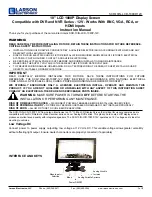
Appendix A: Glossary
A-2 User’s Manual
adjustable display settings, etc. Use channels to switch between a variety of setups
quickly, automatically recalling previously defined display parameters.
A list/menu of previously defined channels available in projector memory.
A number that uniquely identifies a specific channel retained in projector memory.
The projector can retain up to 99 channels.
A menu item that indicates whether an option is currently in effect (checked) or not
(unchecked).
The signal representing the color information (hue and saturation) when the image is
represented as separate chrominance and
luminance
. Same as “chroma”.
The range of colors allowed in a specific system, as defined within a triangular area
located on the CIE color locus diagram whose corners are the three primaries defined
in the system. Also known as color space.
A change in the tint of a white field across an image.
The coloration (reddish, white, bluish, greenish, etc.) of white in an image, measured
using the Kelvin (degrees K) temperature scale. Higher temperatures output more
light.
See
YcbCr
or
YPbPr
.
The output of video tape players and some computers, characterized by
synchronization, luminance and color signals combined on one output cable.
The degree of difference between the lightest and darkest areas of the image.
The alignment of the red, green, and blue elements of a projected image so that they
appear as a single element.
A projection screen which is slightly concave for improved screen gain. Curved
screens usually have screen gains, which are greater than 1 but viewing angles much
less than 180
°
. Curved screens are not recommended for use with this projector.
The Display Data Channel VESA standard enables communication between PCs and
monitors, and is based on E-EDID protocol.
A “direct digital interface” signal can be supplied to the projector via an optional
digital input module installed in
INPUT 5
. For example, you can input an SMPTE-
259M signal using a
Serial Digital Input Module
or input an SMPTE-272M signal
from a
Digital HDTV Serial Input Module
.
Digital Micromirror Devices
used in this projector for processing red, green, and
blue color data.
Located at
INPUT 3
and
INPUT 4
, this device converts NTSC 3.58, NTSC 4.4, PAL,
PAL-N, PAL-M, or SECAM to RGB video.
The sharpness of a display from a video source.
Channel
List
'
Channel
Number
'
Checkbox
'
Chrominance
'
Color
Gamut
'
Color
Shift
'
Color
Temperature
'
Component Video
'
Composite Video
'
Contrast
(ratio)
'
Convergence
'
Curved
Screen
'
DDC
'
DDI
'
DMD
'
Decoder
'
Detail
'
Summary of Contents for DS+5K
Page 2: ...Downloaded From projector manual com Christie Manuals...
Page 6: ...Downloaded From projector manual com Christie Manuals...
Page 98: ...Downloaded From projector manual com Christie Manuals...
Page 110: ...Downloaded From projector manual com Christie Manuals...
Page 114: ...Downloaded From projector manual com Christie Manuals...
Page 128: ...Downloaded From projector manual com Christie Manuals...
Page 130: ...Downloaded From projector manual com Christie Manuals...
Page 148: ...Downloaded From projector manual com Christie Manuals...
















































